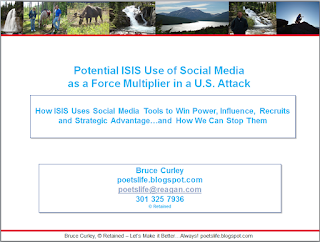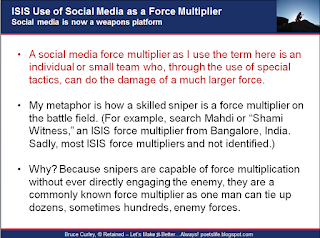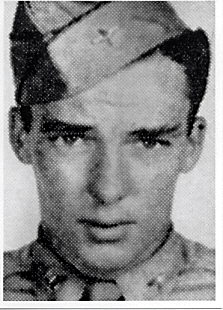
It is a spectacular three-day patriotic celebration of the wonder of men and women who have given their lives for this great nation, and the families that raised them and bore the burden of living long past their young deaths.
One event among many held is the WWII reenactors display.
There, I
had the honor of meeting Jack Wormer who just released his book
(co-author Stephen C. DeVito) called, "Fighting with the Filthy
Thirteen: The World War II Story of Jack Womer - Ranger and
Paratrooper."
Jack
(seen here at 95) was a member of both the 29th Ranger Battalion and
the 101st Airborne's Screaming Eagles. He parachuted behind German lines
on D-Day, fought to Bastogne, and rolled up the Wehrmacht as part of
the Screaming Eagles.
I won't ruin your good read by saying any more.
This is a gritty, closeup story of how fierce the fighting was in that
massive war.
The photo of them side by side is remarkable when you consider that Jack survived fighting behind the German lines and Matt survived the latest phase of the eternal battle. He's squared away...and then some. Read on. [When Jack saw all Matt's medals he quipped: "He better not fall down! He won't be able to get back up from the weight of all those medals!]
Shipley’s tours include Assistant Platoon Commander at SEAL Team
EIGHT, test article Officer-in-Charge of a Mark V Special Operations
Craft (SOC) at United States Special Operations Command, Operations
Officer at Special Boat Unit TWENTY, Mk V SOC Liaison Officer to Special
Operations Command European Command, Naval Special Warfare Task Unit
(NSWTU) Commander for a Mediterranean Amphibious Ready Group, and
Platoon Commander at SEAL Team EIGHT.


At one point when he was getting up to leave, a reenactor nurse came by and helped him to his feet. Then another 92-years vet stepped over and all three stood side-by-side. In the photo, you can see the wonder of this brief meeting.
As he was sitting there, a hard charging soldier ran up and said to him, "Honor to meet you, Sir. I'm a paratrooper, too. Thank you for all you did." It was a beautiful moment seeing a young soldier honoring a man who went before him 75 years ago.
I have written many speeches (such as one to honor Lieutenant Commander Ronald J. Vaulk and Army ChiefWarrant William Ruth), two Mt. Airy residents killed in the Pentagon on 9/1) for our Mount Airy 9/11 remembrance, and I can testify that writing such a speech is very difficult. What Commander Shipley accomplishes in his speech is so much greater than anything I've ever written.

If that had been his entire speech, it would have been more than enough. But he went further.The ending, "Thank you, and America Bless God!!" just slays me. I'd love to see that phrase be as common as "God Bless America!" because it gets the Divine order right.
 .
. 
 "Before I get started I want to recognize American Legion Post 31 for organizing Westminster’s Memorial Day observance for over 80 years, and especially Skip Amass who has put so much effort into planning this year’s event, my brother, Michael, who, last year, asked me if I would participate in this year’s observance, canvassed for me to do it and whose daughters, Kayla and Mary Katherine, I borrowed for the parade this morning, my parents, Michael and Barbara, who are here this morning, and my wife, Christine, who out of 18 years of marriage has faithfully endured more than 9 of them without me.
"Before I get started I want to recognize American Legion Post 31 for organizing Westminster’s Memorial Day observance for over 80 years, and especially Skip Amass who has put so much effort into planning this year’s event, my brother, Michael, who, last year, asked me if I would participate in this year’s observance, canvassed for me to do it and whose daughters, Kayla and Mary Katherine, I borrowed for the parade this morning, my parents, Michael and Barbara, who are here this morning, and my wife, Christine, who out of 18 years of marriage has faithfully endured more than 9 of them without me. 


 Decoration Day
grew in popularity as towns across America followed this example and remembered
their fallen heroes with freshly cut flowers and markers on their graves. As
years passed by and America became involved in other wars, the day became a
time to remember the fallen from each of our wars going back to the first, our
fight for independence.
Decoration Day
grew in popularity as towns across America followed this example and remembered
their fallen heroes with freshly cut flowers and markers on their graves. As
years passed by and America became involved in other wars, the day became a
time to remember the fallen from each of our wars going back to the first, our
fight for independence.
 Westminster, where two companies of
the Delaware Calvary attacked a larger Confederate force under General J.E.B.
Stuart during what has become to be known as Corbit’s charge and Westminster,
which is positioned so close to Gettysburg where the 2nd Maryland
Line Confederate fought the 1st Maryland Infantry, Potomac Home
Brigade at the battle of Culp’s Hill, understood the casualties caused by
having combatants on both sides of the line.
My great grandmother also understood it, because her son, William H.
Shipley, fought at Culp’s Hill, was wounded and left for dead on the
battlefield.
Westminster, where two companies of
the Delaware Calvary attacked a larger Confederate force under General J.E.B.
Stuart during what has become to be known as Corbit’s charge and Westminster,
which is positioned so close to Gettysburg where the 2nd Maryland
Line Confederate fought the 1st Maryland Infantry, Potomac Home
Brigade at the battle of Culp’s Hill, understood the casualties caused by
having combatants on both sides of the line.
My great grandmother also understood it, because her son, William H.
Shipley, fought at Culp’s Hill, was wounded and left for dead on the
battlefield.  Most tragically we are losing over
1,000 WWII veterans each day and with each one passing dies a piece of history,
which has enriched our nation.
Most tragically we are losing over
1,000 WWII veterans each day and with each one passing dies a piece of history,
which has enriched our nation.  Additionally, I had the dubious distinction of being
the executive officer of the SEAL Team that lost the first two SEALs in Iraq
and I can tell you firsthand what that meant.
Additionally, I had the dubious distinction of being
the executive officer of the SEAL Team that lost the first two SEALs in Iraq
and I can tell you firsthand what that meant.  They medivaced him from that position
and the platoon consolidated in another location prior to going back out on the
battle field. Marine Corps Armored personnel carriers transported them to a
building in which the insurgents were reportedly congregating.
They medivaced him from that position
and the platoon consolidated in another location prior to going back out on the
battle field. Marine Corps Armored personnel carriers transported them to a
building in which the insurgents were reportedly congregating.  He returned to our compound on
Thursday and sometime Friday morning he decided he was not ready to have the
service.
He returned to our compound on
Thursday and sometime Friday morning he decided he was not ready to have the
service.  I wish his statement could have been
true, but it was not to be. We were wrapping up combat operations and getting
ready to turn the Area of Operations over to SEAL Team FIVE when the Commanding
Officer approved one last mission.
I wish his statement could have been
true, but it was not to be. We were wrapping up combat operations and getting
ready to turn the Area of Operations over to SEAL Team FIVE when the Commanding
Officer approved one last mission.  Petty Officer Michael Monsoor was
posthumously awarded the Congressional Medal of Honor. Some of you might be familiar with this story
from being featured during the last Republican National Convention in which
fellow SEALs took the gold tridents off their uniforms and pounded them into
the top of Michael’s casket at Rosecrans Cemetery, Point Loma, California. Additionally,
the new movie, Act of Valor, also portrays a similar event based on Michael’s
story.
Petty Officer Michael Monsoor was
posthumously awarded the Congressional Medal of Honor. Some of you might be familiar with this story
from being featured during the last Republican National Convention in which
fellow SEALs took the gold tridents off their uniforms and pounded them into
the top of Michael’s casket at Rosecrans Cemetery, Point Loma, California. Additionally,
the new movie, Act of Valor, also portrays a similar event based on Michael’s
story.  The Commanding Officer cared deeply
for every one of his personnel and after Mark Lee’s death, he would frequently
tell me about how he would lay in bed at night and try to imagine what it was
like to be blind.
The Commanding Officer cared deeply
for every one of his personnel and after Mark Lee’s death, he would frequently
tell me about how he would lay in bed at night and try to imagine what it was
like to be blind.  Petty Officer Ryan Job was an amazing
individual and his story is very inspiring. The grandson of a World War II
fighter pilot, he dreamed of following
in his grandfather’s footsteps and in high school he worked part time as a
janitor to pay for flying classes and earned his pilot’s license at age 17. Later,
while attending his third year of college his ambitions shifted and he dropped
out of the University of Washington to enlist in the Navy to attempt to become
a Navy SEAL.
Petty Officer Ryan Job was an amazing
individual and his story is very inspiring. The grandson of a World War II
fighter pilot, he dreamed of following
in his grandfather’s footsteps and in high school he worked part time as a
janitor to pay for flying classes and earned his pilot’s license at age 17. Later,
while attending his third year of college his ambitions shifted and he dropped
out of the University of Washington to enlist in the Navy to attempt to become
a Navy SEAL.  When he was wounded in Iraq he
completely lost his right eye and it appeared as if the entire right side of
his head was open.
When he was wounded in Iraq he
completely lost his right eye and it appeared as if the entire right side of
his head was open.  After he returned from Iraq, his
girlfriend Kelly, who he wanted to marry prior to his deployment, but postponed
the ceremony for fear of making her a widow, stayed by his side throughout his
numerous brain and facial reconstruction surgeries in many different hospitals
around the nation.
After he returned from Iraq, his
girlfriend Kelly, who he wanted to marry prior to his deployment, but postponed
the ceremony for fear of making her a widow, stayed by his side throughout his
numerous brain and facial reconstruction surgeries in many different hospitals
around the nation.  His other accomplishments after his
recovery included climbing Mount Rainier, training for a triathlon and becoming
a spokesman for an organization that helps wounded veterans transition to
civilian life.
His other accomplishments after his
recovery included climbing Mount Rainier, training for a triathlon and becoming
a spokesman for an organization that helps wounded veterans transition to
civilian life.  Wars have a very real human cost and
it is important that we think about that cost and all those who came before us
who paid the price or those who might do the same in the future. Yet, we should
not limit this to once a year; each of us needs to remember this daily, especially
when we make decisions on how we choose to conduct ourselves as a society.
Wars have a very real human cost and
it is important that we think about that cost and all those who came before us
who paid the price or those who might do the same in the future. Yet, we should
not limit this to once a year; each of us needs to remember this daily, especially
when we make decisions on how we choose to conduct ourselves as a society. That grows on fields where valor led,
It seems to signal to the skies
That blood of heroes never dies.

The pictures below are from the WWII military reenactors. Other reenactors include the Revolutionary War, War of 1812, Civil War, World War II, Korean War, Vietnam War, and Desert Storm.
According to the brochure of the American Legion Post #145:
"Westminster, Maryland has the distinct tradition of having conducted the observance of Memorial Day for 145 continuous years.
This occasion, held to honor those who paid the ultimate sacrifice in the defense of the Unites States, was started in the spring of 1868, led by Miss Mary Shellman, then 16 years old, whose father was the mayor of Westminster."
"Miss Shellman organized the children of the Westminster Elementary School and those of St. John's Elementary School to cut flowers from their gardens, meet at Main and Center Streets,and process to the Westminster Cemetery to place the flowers on the graves of those Union soldiers from the Civil War who were buried there.
 Note: My deep thanks to the WWII reenactors for enduring the extreme heat in their WWII wool uniforms to help myself and others see close up how the soldiers lived in those times.
Note: My deep thanks to the WWII reenactors for enduring the extreme heat in their WWII wool uniforms to help myself and others see close up how the soldiers lived in those times.Contact Arnold "Skip" Amas, Coordinator, American Legion Post #31, 410 848 3326, 410 259 0871, arnoldams@verizon.net.
 From our Founding Fathers struggles against the tyranny of the British Empire to the current wars, freedom and liberty depend on the willingness of brave men and women to stand watch, fight, and sometimes die.
From our Founding Fathers struggles against the tyranny of the British Empire to the current wars, freedom and liberty depend on the willingness of brave men and women to stand watch, fight, and sometimes die.May we remain worthy of their sacrifice by living up to our current demands with the same vigor with which they defended our freedom and liberty in their day.
This event was held on the ground of theAgriculture Museum in Westminster. The photos at the end of this post show our agricultural heritage as it is presented there with farm equipment and machinery, agricultural technology, livestock, and exhibits, such as that on wormsead oil, a product of Carroll County, had the world for its market, from South America, to Asia, to Europe. It cured hook worm in humans and ring worm in livestock]. It is especially well designed for visits from families with small children.
















































